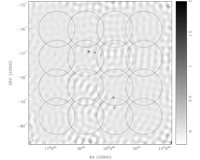First multibeam image for ASKAP's newest receivers
3 November 2015
Early commissioning trials of four ASKAP antennas installed with the second generation (Mk II) phased array feed (PAF) receivers have resulted in the first multi-beam image for the ASKAP team.
The four Mk II PAFs were installed at the Murchison Radio-astronomy Observatory (MRO) in August, and team has been working to commission the receivers and their associated digital spectrometers, beamformers and correlator.
The first, a single-beam image made with four antennas, was of source B0407-658 – the same source used to create a long-track image during early commissioning tests with a Mk I PAF in January 2013.
The second image, and also the highlight of the recent commissioning run, was a 16-beam image of the Apus field, created using three of the ASKAP antennas installed with Mk II PAF systems. The target field contains a suitable arrangement of several strong sources – its proximity to the southern celestial pole has seen it become a standard test field for commissioning – and it was the same source that produced the first multibeam image with the three-antenna BETA sub-array (and software correlator) in 2013.
The multi-beam image of the Apus field has 16 formed (synthetic) beams, more than any other radio image produced with a radio telescope to date! Both images were made from a single linear polarisation and the data were processed (calibration and imaging) using the purpose-built software package, ASKAPsoft.
These observations have also been used to estimate the system noise over the observing band (48 MHz, centred at 939.5 MHz), giving an estimate, averaged over all 16 beams, of Tsys/η ≈ 111 ± 19K.*
This estimate for Tsys/η is within 1‐σ of the aperture-array measurement previously reported for the prototype Mk II PAF.
These results are a positive indication of the performance of the Mk II PAFs as an interferometer, and build on the strong commissioning results already achieved with the first generation receivers (as BETA).
Further integration, verification and commissioning will allow the team to continue to refine their understanding of the performance of this new technology.
*Footnote: The comparatively high uncertainty in this estimate could reflect some systematic effects, a lack of polarimetric calibration or the learning curve associated with beamforming with the Mk II PAFs. More information on this can be found in the latest ASKAP Commissioning Update.
Back to Latest ASKAP News page.

